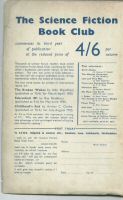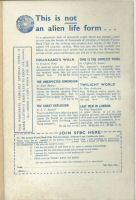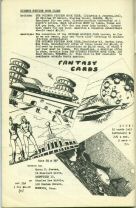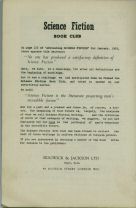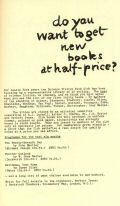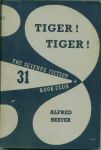SFBC MISCELLANY - advertising,
flyers,
random bits of information and history
Left - BRE ASTOUNDING April 1955 - Right- BRE ANALOG January 1952
The SFBC was not promoted particularly heavily in the British sf magazines. There were ads in NEW WORLDS - including possibly the first public manifastation of SFBC (see below) but few or none in NEBULA or AUTHENTIC. It seems possible there may have been flyers included with the magazines as published, but I have never seen one - possibly none survive even if they ever existed, although flyers for the JAZZ BOOK CLUB from the same publisher (Sidgwick & Jackson) definitely exist and were distributed in jazz magazines of the day.
SFBC was frequently advertised in the British Reprint Edition of ASTOUNDING/ANALOG published by Atlas. (There was no obvious relationship between Atlas and Sidgewick & Jackson). These full-page ads appeared soon after the beginnings of SFBC in January 1953, featuring in many of the digest-size BREs published between November 1953 and August 1963.
all knowledge is in fanzines....
Well, you'd think so wouldn't you, but I have just started researching reaction and commentary on the early days of SFBC in fanzines and so far it's all a bit non-existent. It's incredible really - if I didn't know otherwise and was working from fanzines alone I'd have virtually no clues that SFBC ever existed at all. I am shocked - really, no hyperbole - that something quite fundamental to the British sf culture seems to have gone so unremarked. OK I may have missed something on the first scans, but the words are not leaping off the pages at me, most definately, so let me know what you know.
The only real newszine operating around 1952-52 was the US-based and very US oriented FANTASY TIMES, and so far, zero. So far indeed, I have learned to check twice. Mind you, although I do have as near as dammit a complete run of FANTASY TIMES for the 1950s I am missing, wouldn't you know it, two or three issues for the period in question. If you can help please do so .
The great Ken Slater's OPERATION FANTAST was as surprisingly blank of SFBC commentary as FANTASY TIMES, though I did find two pages in the 1953 edition of OPERATION FANTAST HANDBOOK that are relevant. Though hardly deeply informative. See here -
On a more ground-level note there's a handwritten annotation on the 'Notes' page, probably by the original owner of HANDBOOK 1953, that reads - "Membership No of Sidgwick & Jackson Book Club - S.F. 2896." Gosh. And Wow indeed. This might imply that as early as 1953 there were best part of 3000 SFBC members. Assuming the numbering started at 1....
The vanishing BLOCKHOUSE
Above are SFBC ads from NEW WORLDS, number 78 of December 1958, illustrating a distinct anomaly. Under the heading "SFBC PROGRAMME - November to April '58" it lists Moore's SCIENCE AND FICTION, Asimov's THE NAKED SUN, and, unusually, French author Jean-Paul Clebert's THE BLOCKHOUSE., a novel of a perhaps-true but likely over-fantasised event from the end of Word War 2
The Moore and Asimov certainly appeared as issues 35 and 36 for November 1958 and January 1959 respectively, but number 37 was the more orthodoxly scientifictional title CHILDREN OF THE ATOM by Wilmar H Shiras, the very idea of a reprint of Clebert's unusual novel having fallen by the wayside. Certainly in the next New Worlds ad, in number 81 March 1959, there is no mention of THE BLOCKHOUSE.
So was THE BLOCKHOUSE actually ever a genuine SFBC project, was it a misprint or mistake in making up the ad (certainly the header is wrong - was that all?), or did someone just think Wow, hold on...this may be a strange story but it isn't really SF...
Well, the January 1959 issue of SCIENCE FICTION NEWS (number 36) clarifies the situation:-
Apology
In some recent advertisments for the Science Fiction Book Club it has been incorrectly stated that The Blockhouse was the March 1959 choice, and we apologise to new members who may have been inconvenienced.+
The NEW WORLDS SFBC ads
An earlier incarnation of this webpage asserted (on very shaky ground) that there were few ads for the SFBC in NEW WORLDS in the 1950s. That was despite having a full set of NW barely a metre away from my desk. A more open-eyes research has found at least 17 other incidences of SFBC ads in NW between numbers 19 and 130. Some of them, including what is almost certainly the first announcement of the SFBC, are included here.
I also found the results of the NW Readers Survey for 1958 in which it appears 28% of the respondents asserted they were members of the SFBC. More interestingly still John Carnell specifies that the Survey results were based on the first 500 responses alone - so that would make 140 NW readers in 1958 SFBC members.
Here's a strange thing -
scan courtesy of Jim Linwood -
This is the advertisment for SFBC featured in the Program Book of the 1957 London Worldcon. Now admittedly British Worldcons were a lot smaller back then - less than half the size of an Eastercon of the 21stC - but this is appallingly amateur. It would be fair to say that even individual fanzines and fangroups had better executed advertisments for themselves in 1950s convention publications than this. Surprisingly poor, given that SFBC had been in existence for four years at this point.
Advertisment for upcoming SFBC issue of TIGER! TIGER! - new Worlds 55
Editorial - NEW WORLDS 55 - January 1957
CongratulationsÖ
There are always a variety of subjects upon which an editor can write an editorial although sometimes it is somewhat difficult to decide which theme will be the most popular - or whether the subject which has been held over will be out-of-date before it does appear in print. I didnít have a great deal of difficulty in deciding upon this monthís editorial, however, for birthdays only come once a year and nobody likes to be late with their compliments upon such an occasion.
In this case, January sees the fourth birthday of Britainís own Science Fiction Book Club with a very fine book as its publishing choice - Judith Merrilís anthology Beyond The Barriers Of Time And Space - and I feel that public acclaim concerning the excellent progress the Club has made in the past three years is long overdue.
Despite the fact that I am on the Committee which chooses the six titles a year to be published, it still came as something of a surprise to look along my bookshelf and see the number of outstanding titles the Club has already produced, foremost among them being most of the International Fantasy Award winners and runners-up. Particularly prominent are Stewartís Earth Abides, Vonnegutís Player Piano, Besterís Demolished Man, Sturgeonís More Than Human, and Pangbornís A Mirror For Observers. There have been two Bradbury novels, The Martian Chronicles and Fahrenheit 451, two Stapledon epics which are now priceless volumes - Last And First Men and Odd John - while the list of other authors reads almost like a Whoís Who of science fiction writers Kuttner, Clarke, Asimov, Wyndham, van Vogt, McIntosh, Wilson Tucker and E. C. Tubb (both the last-named with material originally published in New Worlds) and other writers and noted anthologists.
Apart from the first-class titles offered, what has made the S.-F. Book Club so successful ? Basically, it is the loyalty of its reader-members and the interest they have taken in suggesting titles, and, science fiction readers in general being somewhat above the average in intelligence (this statement isnít by any means mere theory) it is not surprising that the Club has such an enthusiastic following.
In general, 1957 is going to be a very poor year for new science fiction books, as few of the general publishers are listing any titles at all and it is now quite evident that there is a considerable recession in progress which will tend to turn novelists away from the field to seek other more remunerative themes. Conversely, magazine sales are steadily rising and it would appear that science fiction is swinging back to its original medium. However, with fewer general s-f books on sale it may well be that the S-F Book Club will increase its membership still further during the next twelve months as there are sufficient tales in hand to carry the Club on for several years if necessary. One of the main policies of the Club has been to publish each year the best of the new titles from the general publishers - the dearth of new titles will now bring forward the backlog of outstanding novels which has been held over. There is a big difference in the principles of Book Club publishing in Great Britain and that of the USA - in Britain, Book Club editions cannot be published earlier than one year after the original regular edition. Also, Book Club publishers cannot offer free books or any other form of inducement as a means of increasing their membership. Whereas, in America, all kinds of free offers are put forward to attract new members.
Many book dealers in USA maintain that the Doubleday Science Fiction Book Club was responsible for killing the general science fiction book market in their country by offering regular editions of science fiction books published by leading houses at give-away prices. Often, it seemed, such volumes were offered free to prospective Book Club members almost before they had been on sale through the normal retail channels. While this is a debateable point - it may well have been that American publishers found exactly the same position a year ago as British publishers are now finding, that science fiction novels do not sell as well as general novels - it is a comforting thought that such an eventuality cannot happen in this country owing to the conditions laid down by the Publishersí Association in relation to Book Club editions.
In that factor lies the strength of the S-F Book Club, plus the extremely low cost of each volume for those who want to build a small inexpensive library of outstanding novels. For that reason also I would like to wish the Club many happy returns of the day.
John Carnell
The issue of A CANTICLE FOR LEIBOWITZ
The odd one. Everybody knows
that SFBC 52, Walter M Miller's A CANTICLE FOR LEIBOWITZ is the
one that won't fit on the shelf. It's 8&three-quarter inches
tall, as opposed to the 7&half of the rest of the first 60 or
so issues (there were slight variations in size from issue 55 on,
but none so large). That oddity is invariably remarked on when SFBC
fans get together (if you can find more than one at any given moment,
that is...) and Rog
Peyton's opinion
here is typical -
"I have the original Weidenfeld edition
of CANTICLE..., which is in the larger Crown size, but I've not
compared it with the SFBC edition. It's almost certain that the
SFBC edition was printed from the Weidenfeld (or the USA Lippincott)
plates, The Weidenfeld edn was printed from the US Lippincott plates,
though with section title pages reset."
Dave Wood
has similar ideas -
"Well, I have a theory it has all to
do with plates. The series was based on reprinting already published
works in the {then] Crown 8vo. I've compared my SFBC copy of Kuttner's
Fury with the Dobson edition. - they are the same."
Now the facts - from SCIENCE FICTION NEWS 56, December 1961
FORM AND CONTENT
Ever since we sent out A Canticle for Leibowitz we've been receiving letters about it. Mostly they have been complaints about the regrettable fact that the book was not the same size as previous SFBC editions. Few members could bring themselves to comment, either favourably or unfavourably, on the book itself, which suggests that sf enthusiasts are pretty keen on regularity at all costs.
Be that as it may - and we don't wish to imply that members haven't read Canticle though we do wish they'd tell us if they liked it - an explanation seems called for.
Canticle was an odd size because - well, chiefly because it started out that way. In other words, its format was different in its original edition from that of most novels and certainly from most sf novels (probably because the original publishers were once bitten by a Venusian and wanted Canticle to look as little like sf as possible). By now some wiseacre is probably muttering in the back row that by means of photo-lithography (the process by which we printed our edition) it is possible to reduce the page size to that of the usual 7 by 4 inches. True - but not in this case because we were using existing lithographic plates and to reduce the size would have meant re-photographing, which we could not have afforded on our already expensive production.
But - now that that is out of the way - this raises a wider issue. Do we turn down books because - and only because - they can't be poured into a 7 by 4 inch mould? Sure, we say the books are standard format and we mean it, but is it worth deviating (once in a year or two) when we have an exceptional 'odd man out'?
We say 'yes, emphatically'. We don't refuse champagne in a tumbler, nor do we insist that every related book on our shelves be precisely the same size although we do endeavour to maintain a uniformity of style. But the important point is that the originals from which we work are issued by different publishers and hence no absolute identity of size, style or typography can be ensured.
We do what we can, but within limitations, to ensure that club editions look like club editions - but we cannot always achieve absolute similarity.
However, chances are that Leibowitz will remain the exception for as long ahead as we can see. And we still think it's a masterpiece.
Oliver Caldecott
Distressing, really, to see such evidence of how sheeplike and conservative even the elite sf fans who were SFBC members could be. Also it's an early example of the "it's too good to be sf so we just won't mention it" ploy from a publisher. Nothing's new eh.
and what the Big Fat Books say
SCIENCE FICTION BOOK CLUBS - from the ENCYCLOPEDIA OF SCIENCE FICTION
1979 - First edition -
SFBCs were started in both Britain and the USA at roughly the same time (c.1953). The British version was owned in its early years by Sidgwick & Jackson, and more recently by Readers Union: the American book club is owned by Doubleday. The two clubs operate somewhat differently. In Britain the SFBC, with very few exceptions, chooses among recent hardcover titles, reprinting the hardcover edition (or having the publisher print extra copies for its use). It does not set its own books. In America, the club, which is proportionately far larger, offers a wider selection, publishes its own editions, (including special hardcover editions of paperback originals) and creates books - omnibuses of various sorts - especially for its members. In recent years the American SFBC has become one of the major forces in sf publishing, while its British equivalent remains a comparatively minor adjunct to the publishing industry in the UK.
Malcolm Edwards
1993 - Second edition -
SF Book Clubs were started in both the UK and USA at roughly the same time (c1953). The UK version was owned in its early years by Sidgwick & Jackson, then by Dent as part of the company's Readers' Union group of Book Clubs, and finally by David & Charles, who bought the Readers' Union group in the 1970s. David and Charles's management, which contained no SF enthusiasts, was apathetic towards the SFBC, which later became subject to competition from Encounters, a book club aggressively promoted by the larger group Book Club Associates. Even before the death in 1982 of its freelance consultant Edmund Cooper, the editorless UK SFBC was slowly petering out, despite part- and spare-time efforts of one Readers' Union employee, Paul G Begg, to keep it alive; it dies altogether some time after Begg left the company.
The US SFBC by contrast has had a history of continuity. .....(Some publishing details omitted here.)...... The US club is far larger than the UK club ever was, offers a much broader selection, publishes its own editions (including special hardcover editions of paperback originals) and creates books - omnibuses of various sorts - especially for its members. (The UK club normally presented no more than one title per month, reprinted cheaply on cheap paper and with a cheap binding and cover.) The US SFBC has been a major force in publishing.
Malcom Edwards, Peter Nicholls, John Grant
(Emotionally
I feel I want to contend the unfavorable compare and contrast of
the UK SFBC to its US counterpart, but, well, it's all probably
true. I have quite a lot of the US SFBC editions and they are by
and large handsome objects, and while it is arguable that overall
the quality of the US choices is superior to the British, I
still stand by my contention that the First 150 UK SFBC titles offer
a really excellent picture of the best of sf up to the end of the
1960s.
Just one
little thing too - the US SFBC editions have no numbers....and,
while I'm at the barricade, I really like the British covers, at
least up to issue 110... Greg Pickersgill
- 2006)
The SCIENCE FICTION ENCYCLOPEDIA today (well, today, 24 April 2025 OK?)
SCIENCE FICTION BOOK CLUB - from Donald H Tuck's ENCYCLOPEDIA OF SCIENCE FICTION AND FANTASY (published 1982, but coverage has cut-off date of 1968)
The book club sponsored by the publishers Sidgwick & Jackson, London. The original selection panel in 1953 was A C Clarke, J G Porter, E Shanks, and E J Carnell. Around 1958 Herbert Jones replaced Shanks, by 1961 the panel was Carnell, Porter, and Kingsley Amis.
Titles were initially priced at 6/-, but soon dropped to 4/6; by 1958 they became 5/6 and then 5/9 in 1962. Sround September 1963 they became 6/- and by mid-1968 were 8/-. Specials were priced higher. Selections were made bimonthly to start, but have been monthly since 1961.
Donald H Tuck
